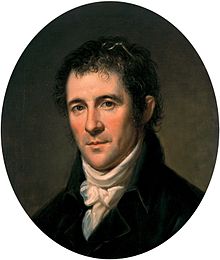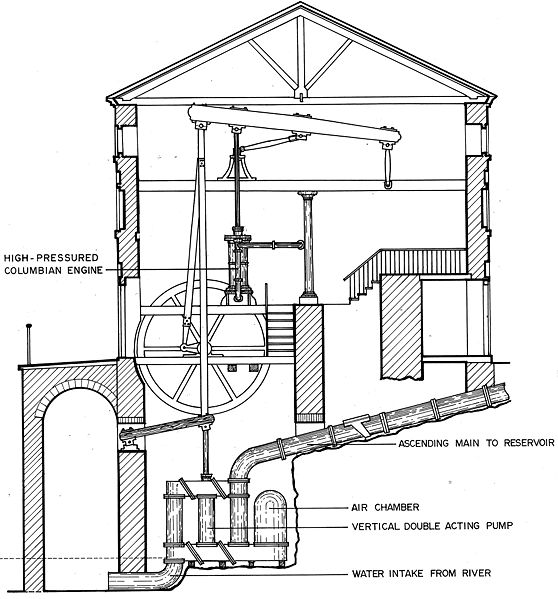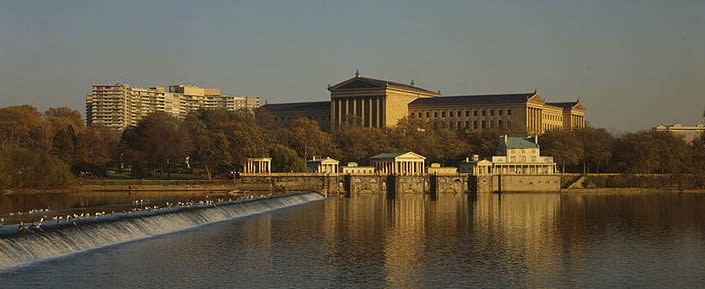This Week in History:
January 20-26, 1801
Benjamin Latrobe Designs the first American Steam-Powered Municipal Waterworks
January 2012
 Benjamin Henry Latrobe, 1764-1820. Portrait by Charles Wilson Peale ca. 1804. |
John Latrobe recorded in his journal, that on the night of Jan. 21, 1801, his father Benjamin, "with three gentlemen, his friends, and one of his workmen, kindled a fire under the boiler, and set the ponderous machinery in motion while the city was buried in sleep." In the morning, "the streets of Philadelphia were flowing with water from the gushing hydrants." That city had enjoyed a safe and efficient supply of water during Colonial times, thanks to the improvements wrought by Benjamin Franklin's organizing efforts. By 1776, public pumps dotted the curbstones, and produced a steady flow of clean water. But, as the population grew from 25,000 in 1776, to more than 70,000 as 1800 approached, water from the shallow wells became polluted.
Beginning in 1793, Philadelphia had been decimated by yearly yellow-fever epidemics, causing the Federal government and much of the population to flee the city. Philadelphia's doctors began to wonder if there was a connection between the water supply and the yellow-fever outbreaks. In 1797, hundreds of Philadelphia's citizens petitioned the City Council to install a municipal water system.
Benjamin Latrobe, newly arrived from Virginia, submitted a plan in December of 1798, which called for a steam engine, of which there were then only three in the new nation, to pump water from the Schuylkill River through underground tunnels for nearly a mile to Central Square. From there, another pump, hidden in a white marble Grecian temple, would raise the water to a reservoir. The water would then flow downward and into the city through buried wooden pipes. Nicholas Roosevelt, whose works were located on the Passaic River in New Jersey, gave assurances that his machine shop could build the required steam engines.
Oliver Evans, inventor of the first automated flour mill, and pioneer in steam-engine manufacturing, objected that the reservoir was just barely adequate for the city's current needs. He argued that a reservoir should be built in elevated country north of the city and should hold many thousands of gallons of water. Latrobe was awarded the contract, due partly to his study of British waterworks, and partly to his experience in supervising complex projects and large work crews in Virginia, where he had improved the navigation of the Appomattox and James Rivers, and worked on draining the Great Dismal Swamp.
Latrobe began construction in May 1799, and finished in January 1801. The project gave Philadelphia the first, and for many years the best, water system in the nation. Two tunnels, six feet in diameter and nearly a mile long, were cut through granite rock and lined in brick to carry the river water to the marble temple, now the site of Philadelphia's City Hall, but, in those days, a meadow, which was made into a park. For the construction, Latrobe gathered craftsmen and mechanics from all parts of America and from Britain, who then fanned out to other cities to replicate what they had built in Philadelphia.
The Roosevelt steam engines performed well, pumping water at 12 strokes a minute. A contemporary described the innovation which Roosevelt had developed: "The air pump is an improvement upon that used by Boulton and Watt; consisting in its evacuating the condenser twice at every stroke, thereby creating a much better vacuum, and of course adding considerably to the power of the engine, in proportion to the diameter of its cylinder without increasing friction."
The waterworks became a showpiece in the midst of a park where Philadelphia's Fourth of July celebrations were held. Even Oliver Evans used the Greek temple as the background for a demonstration of his steam-powered river dredger. The waterworks continued in operation until Sept. 7, 1815, when they were replaced by the Fairmount Waterworks, built by one of Latrobe's pupils. As Evans had proposed, a larger reservoir was built north of the city, and one of the steam engines that pumped the water was designed and built by Oliver Evans's Philadelphia machine shop, the Mars Works.
 Fairmount Waterworks steam-powered pump cutaway view. |
|
Benjamin Latrobe continued his service to the nation in his capacity of surveyor of the public buildings in Washington, D.C. He supervised the construction of the south wing of the U.S. Capitol, and it was he who devised the "American order" of maize for the capitals of the columns. He worked on the White House for President Thomas Jefferson, and was appointed Engineer of the Navy Department, in which capacity he designed the Navy Yards at Washington and New York. After the British burned the Capitol during the War of 1812, Latrobe was called in to rebuild the House and Senate Chambers. For the vestibule of the Senate, he designed capitals based on the flowers and leaves of the tobacco plant, to complement the maize capitals of the House.
When the War of 1812 suspended his government work, Latrobe went into partnership with Robert Fulton, Robert Livingston, and Nicholas Roosevelt to build steamboats adapted to navigate the Ohio River. Although Latrobe moved his family to Pittsburgh, the death of Robert Fulton stopped the project and put Latrobe heavily in debt. He was forced into bankruptcy, but he wrote to one of his creditors: "Your claim on me is of a nature which no legal release can absolve—the field of productive activity before me is such, as to assure me—if I live—of the certainty of not disappointing your confidence in me."
Latrobe was consulted about building a water supply for New Orleans, and he sent his son Henry to supervise the project. During the War of 1812, Henry took part in the defense of the city and began construction of a lighthouse at the mouth of the Mississippi. When Henry died of yellow fever in 1817, Benjamin Latrobe brought his family to New Orleans and was pushing the construction of the water system to conclusion when he, too, was stricken with yellow fever and died in September of 1820.
Latrobe's two surviving sons, however, carried on his architectural and engineering tradition. John Latrobe, a West Pointer, combined his father's tradition with law by serving as counsel to the Baltimore & Ohio Railroad. It was he who recognized the importance of Samuel Morse's invention of the telegraph, and recommended it to the B&O president, who in turn granted Morse the privilege of stringing the first telegraph line between Baltimore and Washington along the railroad's right of way. As a writer of some note, John Latrobe also served on the committee which awarded a prize to Edgar Allan Poe for "A MS. Found in a Bottle."
John's brother, Benjamin Henry Latrobe II, worked in the engineer corps of the B&O Railroad, and in the early 1830s, he designed the Thomas Viaduct at Relay House, southwest of Baltimore, which is still in use today, and successfully carries modern railroad equipment. He then surveyed and built the railroad from Point of Rocks to Harpers Ferry, and then from Harpers Ferry to Cumberland. In 1847, he laid out the line all the way to the Ohio River and supervised 5,000 men and the 1,250 horses they used for hauling away the rocks they blasted out with black powder. His crew built 200 miles of railroad, including 113 bridges and 11 tunnels in less than four years. His son, Charles, also became an engineer and designed a railroad for the Peruvian government which featured a bridge which spanned one of the deepest gorges in the Andes. The bridge was framed in the United States, taken apart for shipment, and re-framed in Peru in ninety days.
The original article was published in the EIR Online’s Electronic Intelligence Weekly, as part of an ongoing series on history, with a special emphasis on American history. We are reprinting and updating these articles now to assist our readers in understanding of the American System of Economy.

